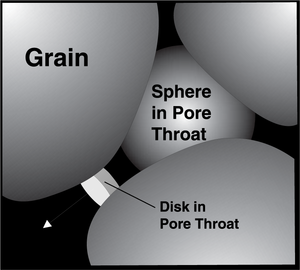Pore and pore throat sizes
| Exploring for Oil and Gas Traps | |

| |
| Series | Treatise in Petroleum Geology |
|---|---|
| Part | Critical Elements of the Trap |
| Chapter | Predicting reservoir system quality and performance |
| Author | Dan J. Hartmann, Edward A. Beaumont |
| Link | Web page |
| Store | AAPG Store |
Pore and pore throat sizes have two defining parameters
- Absolute size
- Aspect ratio
Absolute size
Absolute size of a pore throat is the radius of a circle drawn perpendicular to fluid flow and fitting within its narrowest point. Absolute size of a pore is the radius of the largest sphere that will fit inside it. The cross-sectional shape of fluids moving through intergranular porosity is roughly circular. Both pores and pore throats can be divided into petrophysically significant size ranges.
Measuring pore and pore throat sizes

Figure 1 illustrates the concepts of pore size and pore throat size determined by measuring the radius of a sphere in the pore and the radius of a disk in the pore throat. Pore size can be estimated visually by using an SEM (scanning electron microscope), for example. Pore throat sizes for a rock can be measured using capillary pressure–mercury injection tests, which can be converted to a distribution or profile of pore throat sizes for a sample. Erlich et al.[2] describe a procedure for estimating pore and pore throat size from thin section image analysis.
Aspect ratio
Aspect ratio is the ratio of pore size to pore throat size. Geometrical reasoning and limited experimental data suggest that aspect ratios have small ranges in intergranular and intercrystalline pore systems (see Reservoir quality). Disparate Archie rock types such as quartz-cemented sandstones, bioturbated sandstones, and sucrosic dolomites have aspect ratios that range between 5:1 and 10:1. Non-Archie rock types have even larger variations in aspect ratios.
See also
- Pore systems
- Pore system fundamentals
- Pore system shapes
- Pore throat size and connectivity
- Capillary pressure (Pc) curves: pore throat size determination
References
- ↑ Coalson, E. B., S. M. Goolsby, and M. H. Franklin, 1994, Subtle seals and fluid-flow barriers in carbonate rocks, in J. C. Dolson, M. L. Hendricks, and W. A. Wescott, eds., Unconformity related hydrocarbons in sedimentary sequences: Rocky Mountain Association of Geologists guidebook for petroleum exploration and exploitation in clastic and carbonate sediments, p. 45-58.
- ↑ Erlich, R., S. J. Crabtree, K. O. Horkowitz, and J. P. Horkowitz, 1991, Petrography and reservoir physics, 1: objective classification of reservoir porosity: AAPG Bulletin, vol. 75, no. 10, p. 1547–1563.